My Top 10 D&D Illustrations of the Golden Age (Part I)
Ever since I started doing these Top 10 lists earlier this month, I've received a lot of positive feedback, including email suggestions of other lists I could present. One of the most requested of these other lists concerns the art of Dungeons & Dragons, namely my favorite pieces. There's no question that this is a good topic for a list and will generate a lot of discussion, but I must admit to some hesitation nonetheless. Judging art is often subjective, especially gaming art, appreciation of whose qualities can depend on numerous factors beyond the specific piece of art under discussion. It's also been my experience that there's something of a difference in tastes between age cohorts of D&D players, with those encountering the game in the mid to late 1980s having a different notion of what makes good D&D art than those, like myself, coming from just a slightly earlier era.
Nevertheless, I do think there's something to be gained by proposing a list of my Top 10 D&D illustrations. As before, I am limiting myself to the Golden Age of the game, since it's the era when I first encountered it. The imagery of that era made a strong impression on me and, as a result, most of what I think of as the best illustrations for the game were created during its first decade of publication. Also as before, I make no claims to objectivity or universal appeal. The ten illustrations that will appear here and in its follow-up post later in the week are those that I like, for reasons I will explain. Naturally, some will disagree, perhaps vehemently with my choices and that's fine. My only hope is that, in offering my list, I might encourage conversation rather than mere argument.
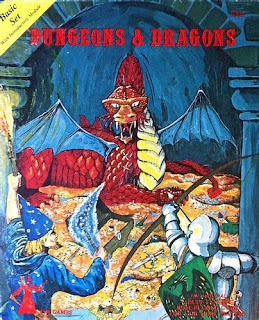 10. Dungeons & Dragons Basic Set (1977)
10. Dungeons & Dragons Basic Set (1977)This painting, by David C. Sutherland, is perhaps the very first piece of D&D art I ever saw and is, therefore, forever linked with the game in my imagination. There was simply no way I could justify excluding it, despite its clear technical deficiencies. Of course, if I were to exclude illustrations on such a basis, I'd have to rule out almost all of those on this list. Even so, there's a lot to like in this particular piece, starting with the fact that it clearly shows a knight in historical armor standing beside a traditional-looking wizard as they face off against a dragon resting atop a vast treasure hoard. For a game called Dungeons & Dragons, this is nearly ideal in conveying what the game is about. I can't tell you how many hours I probably spent staring at this image in late 1979 and early 1980. The illustration reached out and seized me in a way I still cannot adequately explain. In my mind's eye, this is what D&D looks like.
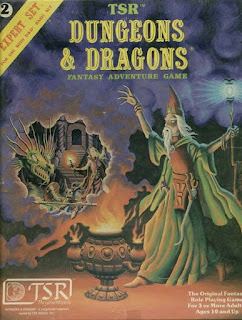 9. Dungeons & Dragons Expert Set (1981)
9. Dungeons & Dragons Expert Set (1981)This is a slight cheat, in that the cover for the Expert Set by Erol Otus also incorporates a portion of his Basic Set cover as well. That said, I actually like the Expert Set illustration a bit more, since it highlights one of Otus's funky wizards, whom I found equally fascinating and unsettling as a youth. More to the point, since I already owned the Holmes-edited Basic Set (see above), I didn't see any immediate need to buy the 1981 Moldvay set, opting for the Expert Set alone (a situation I would later rectify). In fact, I often stuffed the Expert rulebook inside my Holmes box when I took it with me to friends' homes to play. Together, they formed the basis of my foundational D&D experiences and I find it hard to separate the two. However, I rate this illustration slightly higher solely on the basis of the greater skills of Erol Otus. His illustrations were always weird and evocative and did a lot to broaden my conception of what fantasy was and could be.
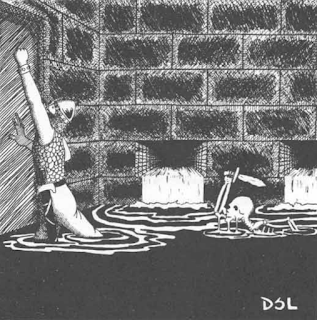 8. "Skeleton Trap" (1979)
8. "Skeleton Trap" (1979)This illustration, by David S. LaForce, appears in the AD&D Dungeon Masters Guide. In terms of its composition, it's nothing special, but it's a piece that's fascinated me for decades nonetheless. What I think elevates it above so many other "better" illustrations is the sense of inexorable doom it conveys – a key feature of many early D&D sessions. The room is filling with water; the only means of obvious escape is barred. And there's also an animated skeleton in the room, emerging from beneath the water. Does the hapless fighter on the left know he's about to be attacked from behind? Is he simply more concerned about the rising water level in the room? I pondered these questions a lot when I was younger. Consequently, t's an illustration that's stuck with me over the years.
7. "Dragon Attack" (1981)
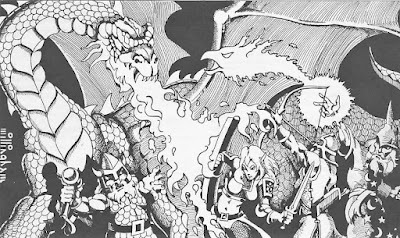 Unlike many of my peers, I've never been a huge fan of Bill Willingham's artwork. That's not a knock against Willingham's work, which is quite good but a little too "comic book-y" for my tastes. Nevertheless, I consider the frontispiece of the 1981 D&D Basic Set pictured above to be one of my favorite illustrations of the Golden Age. Much like the Sutherland cover to the Holmes Basic Set, it scores a lot of points simply for the fact that it depicts a confrontation with a dragon. Where it is superior to Sutherland's piece – and why it is higher on my list – is that it comes closer to depicting a proper party of adventurers, in this case a dwarf, an elf, a fighter, and a magic-user. The composition is a little odd, in that the adventurers are practically right on top of the dragon, but I can overlook that, because of how dynamic and exciting the scene is.
Unlike many of my peers, I've never been a huge fan of Bill Willingham's artwork. That's not a knock against Willingham's work, which is quite good but a little too "comic book-y" for my tastes. Nevertheless, I consider the frontispiece of the 1981 D&D Basic Set pictured above to be one of my favorite illustrations of the Golden Age. Much like the Sutherland cover to the Holmes Basic Set, it scores a lot of points simply for the fact that it depicts a confrontation with a dragon. Where it is superior to Sutherland's piece – and why it is higher on my list – is that it comes closer to depicting a proper party of adventurers, in this case a dwarf, an elf, a fighter, and a magic-user. The composition is a little odd, in that the adventurers are practically right on top of the dragon, but I can overlook that, because of how dynamic and exciting the scene is. 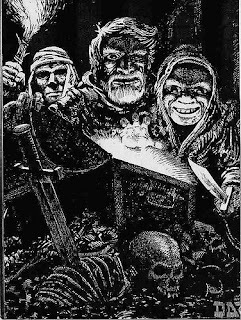 6. "Treasure Hunters"
6. "Treasure Hunters"This Dave Trampier illustration, from the AD&D Players Handbook is favorite of mine for a number of reasons. For one, I think it's among Tramp's best pieces of work. The use of light and shadow is quite effective. For another, I love the faces of the three adventurers. They palpably evince greed, with the one on the far right unable to prevent his hand from reaching into the chest and grabbing what's within. Also, these aren't Hollywood handsome protagonists posing heroically for the cameras. They're rough and tumble rogues of the sort Robert E. Howard, Clark Ashton Smith, or Fritz Leiber might have created. They're perfect exemplars of the pulp fantasy literary inspirations of D&D that was largely discarded by later editions of the game. We need to see more dubious characters like this in D&D artwork, if you ask me.
James Maliszewski's Blog
- James Maliszewski's profile
- 3 followers



